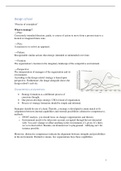Design school
“Process of conception”
What is strategy?
→ Plan:
Consciously intended direction, guide, or course of action to move from a present state to a
desired or imagined future state.
→ Ploy:
A manoeuvre to outwit an opponent.
→ Pattern:
Recognizable similar actions that emerge (intended or unintended) over time.
→ Position:
The organization’s location in the imaginary landscape of the competitive environment.
→ Perspective:
The interpretation of managers of the organization and its
environment.
According to the design school strategy is based upon
perspective. Furthermore, the image alongside shows the
design school’s activity.
Characteristics and premises
• Strategy formation as a deliberate process of
conscious thought.
• One person develops strategy: CEO or head of organization.
• Process of strategy formation should be simple and informal.
Strategies should be one of a kind. Thereby, a strategy is developed to attain match or fit
(alignment) between internal capabilities and external possibilities (distinctive competences),
methods:
o SWOT analysis, you should focus on changes (opportunities and threats).
o Environment needs to be taken into account, navigated through but not interacted
with. You can’t change or affect anything in the environment, it’s given. It’s there,
we’ve to deal with it. Besides, environment isn’t a playground – lobbying isn’t for
instance possible.
Moreover, distinctive competences indicate the alignment between strengths and possibilities
in the environment. Distinctive means, few organisations have these capabilities.
1
,Design school process
The strategy design process is complete when
strategy appears fully formulated as a perspective.
This strategy is explicit and isn’t very detailed.
Moreover, implementation follows formulation and
analysis.
The strategist: CEO or head of organization
Got several tasks:
• Gather information
• Analyze information
• Organize information
• Formulate information
Idea of CEO to be main strategist is still very much alive (statements are scientifically
proven):
• ‘Uncommon CEO names lead to more deviating strategies.’
• ‘CEO’s cognitive flexibility aids the development of dynamic capabilities.’
• ‘CEO characteristics determine the kind of acquisitions of a firm.’
Organization structure
“Structure follows strategy”
Strategy determines long-term goals and objectives, the source of action and allocation of
resources. Structure is the design through which to administer the strategy. Changes in an
organization’s strategy led to problems that require a new structure.
Summary assumptions
• The CEO or head of organization has complete and perfect information. Thereby, he
has also the mental/cognitive capacity to accurately process all information.
• The environment can always be understood. Furthermore, situations (future) and the
environment are predictable and stable.
• All information is documented and available.
• Strategy is centrally formulated.
Criticism and limitations
• Structure follows strategy, unrealistic for most organisations. Radical change in
strategy, would mean a complete overhaul in the organisation’s structure.
• The capacity to learn over time (experience) is ignored by analytical assessment of
environment and internal capabilities.
• Promotion of inflexibility: hierarchical, centralized and explicit strategy formulation.
• Detachment of thinking from acting.
Additional criticism
CEO or head of organization is unlikely to have all and perfect information and the capacity
to process this information (bounded rationality). Rationality is limited and individuals make
2
,imperfect decisions – due to, for instance: difficulty of the problem, boundaries to cognitive
capability, limited time.
Contributions
• Vocabulary and tools (SWOT analysis)
• Grand strategy (overarching perspective that guides an organisation)
• Basic notion: fit between external environment and internal capabilities
• Started to promote the relevance of strategy in organizations and as a field of research
Side notes
• Strategy is a learned kind-of-thing.
• Lack of feedback loops or iterative process, as the design school is descriptive.
• What the environment allows us to do – versus, what can we do, or are able to do.
• SWOT analysis is a tool for implementing strategy. Downside of the analysis:
o Lack of uniqueness
o Contributes to universality, it fits all (e.g., black dress)
Moreover, the design school is most applicable for strategy formation in young and
entrepreneurial organisations (strategy precedes structure). It’s very difficult to change a
structure in an old and established firm.
3
, Planning school
“Formal process”
What is planning?
The establishment of goals, policies and procedures
for a social or economic unit. In strategy,
a formalized procedure to produce articulated results
by using and integrated system of decisions. Besides,
the image alongside shows the planning school’s
activity.
Origins planning school
Military – organisations and military must adapt to change and constantly improve to gain or
maintain an advantage. Actually, organizational strategy assumes competition, whereas
military strategy assumes conflict. Moreover, strategy is seen as a result of:
• Formal procedure
• Formal training
• Formal analysis
• Lots of numbers
Characteristics and premises
• Strategy is driven by insights into regularities.
• Strategy formation is a conscious, formal and controlled process. It is supported by
checklists and analytical techniques.
• Strategy is decomposed into distinct steps. For instance, planning and implementation
are separate, consecutive steps. Besides, the picture below exhibits the planning
school’s strategy process.
• The planning school wields a rational and systematic approach to strategy making –
affected by scientific management.
Additional premises
• Organizations are like machines.
• Organizations have a clear-cut system of values, competencies and reward system.
These are easy to recognize.
• Responsibilities are divided.
• The (future) environment is stable and predictable. Focused on the future
environment, instead of the current environment (design school).
4






